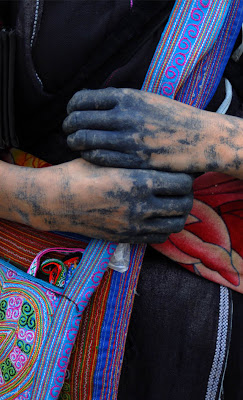Well, this post has nothing to do with kimono fabrics, but I have just returned from my three week trip to Vietnam and Cambodia. Our trip began with what turned out to be the hardest but one of the most rewarding parts of our travels, Sapa in the northern mountains of Vietnam.
With an interest in traditional costumes, textiles and indigo, I was really hoping to see some of the Black Hmong people native to the region. On the trip up the winding, wet mountain road, I desperately wanted to get our driver to stop each time I saw someone in the traditional wear, fearing that they may be the last I saw. I shouldn't have concerned myself at all. The moment I hopped out of the minivan in the Sapa township, I was adopted by two teenage Hmong girls who took it upon themselves to be my guides for the duration of our stay.
The Black Hmong are famous for their very dark indigo fabrics embellished by hand embroidery. The indigo plant is native to the Sapa region. During my two day trek, my guide picked some indigo plant leaves for me. I'm not sure what I was expecting, but I'm sure it involved something blue. What I was handed however was a large, very green looking leaf. I added the leaf to the other wildflowers children had put into the top of my bamboo walking pole. By the next day, the leaf had begun to wilt and give away a few of its blue secrets.
Many of the women in the villages are involved in the long dyeing process. I found this information on the technique;
Indigo plants are cultivated in neat plots on the hillsides near the houses. The
plant grows to about 60 cm high and can yield 2 crops each year. The dye is
contained in the leaves which when allowed to ferment and then oxidise produce a blue powder that is insoluble in water. This can be stored as a paste or powder. There are various ways of preparing the Indigo vat with substances that make the Indigo soluble. The urine of children, particularly boys is a common additive as well as lye, lime and rice wine. When the dye bath is bubbling strongly it is ready to use. The fabric is emersed in the dye vat and worked for about half an hour then hung up to oxidise into the distinct blue colour. Subsequent dippings and oxidations will darken the colour and the black of the Hmong fabrics is achieved by repeating the process twice a day, each day for a month.
The page I sourced this information from has detailed information about the textiles and costumes and is an interesting read here.
Our trek took us through one of the Hmong villages and while I wasn't lucky enough to see any of the dyeing in action, I was taken into the home of a hemp spinner. The room was very dark and the floor was uneven, hard packed dirt. There was no electricity or running water to the house and cooking was done over a fire in the middle of the floor in the kitchen. The spinner was working on with a large wooden frame with the only lighted supplied by a hole in the thatched roof above.
The hands of a Black Hmong girl
The hands of many of the Hmong girls and women are permanently stained from the dyeing process.

Wayne having fun buying from the girls
Over the course of the three days in Sapa, I bought many Hmong textiles, mostly in the form of pillowcases and bags. I will treasure them forever remembering the hands that made them, hands that live in poverty but yet in such a rich culture.





4 comments:
Thank you for your great article and the time, travel and pictures involved.
I wish industrial hemp could come out of the closet in the USA.
I thought hemp would be too rough to make such fine material. I wonder how much silk was in some of their weaving? The process of taking hemp fiber to something that could spin with silk must take a lot of effort.
Hi!
It is such beautiful fabric, but I believe it is 100% with no silk. The link in the post goes into a lot of detail about the process. I believe this (taken from that link) may explain why the fabric looks so fine;
" " Beetling " or " Calendering " is a finishing process which flattens the threads and fills in the spaces between warp and weft. The cloth becomes finer, smoother, softer and more lustrous - almost with a metallic sheen. The women use a well worn, rounded, log which sits flat on the ground and a flat , long shaped rock which sits on top. Maybe the rock I saw being used was petrified wood as the woman I was with indicated it was the same as the wood.
The fabric is placed over the wood and the rock, treated with beeswax, placed on top. The woman balances on top of the rock with her feet apart and moves side to side in a see saw action back and forward. At the same time the cloth moves to the left of the wood so that the length can be worked in a continuous process."
Gorgeous blog!
I mentioned your article on your visit to Thailand and your blog in mine today and added you as a link. Come visit!
Beautiful post, I'm planning to link here from my own post - hope that's ok! Thanks for great images.
Post a Comment